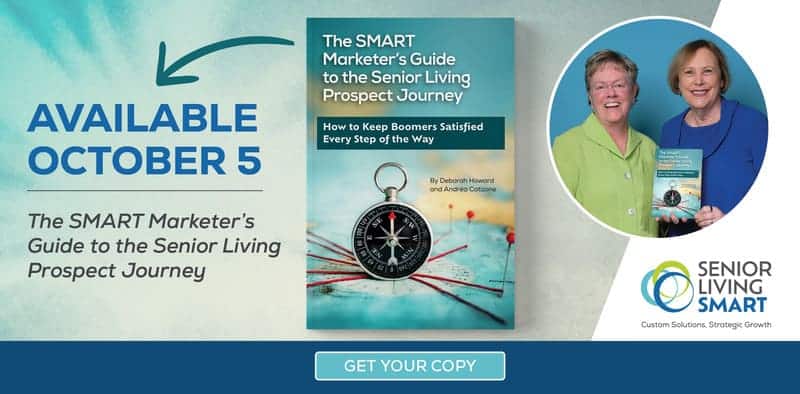Content Tips for Better Senior Living Advertising Campaigns
Advertising remains an important component of effective marketing plans—whether we’re talking print ads, direct mailers, highway billboards, or digital ads. But like any other marketing tactic, you need the right content. So let’s discuss senior living advertising campaigns, specifically the content that will (hopefully) inspire people to act.
Put extra effort into your headlines.
When it comes to advertising, headlines do the heavy lifting. According to Copyblogger, “On average, 8 out of 10 people will read headline copy, but only 2 out of 10 will read the rest.”
Headlines should be clear, concise, and compelling. Clear means easy to read and easy to understand. Concise means short, but what qualifies as short? It depends on the medium, and not everyone agrees on the right number of words. We usually recommend 5-10 words, but that doesn’t mean a three-word headline couldn’t pack a punch or that a 15-word headline wouldn’t work.
As for compelling . . . you want headlines that capture people’s attention. The headline should inspire the person to keep reading. Common strategies for creating a compelling headline include:
- Asking relevant questions that your personas are already asking (or should be asking).
- Being cute, coy, or playful (or some combination of the three).
- Tapping into people’s pain points (for example, their fears and concerns).
Think through the call-to-action.
After your headline, your call-to-action (CTA) is probably the most important part of your ad. People commonly scan ads (and articles). Their eyes will focus on things that are prominently displayed, like headlines, sub-headlines, anything that’s bolded, and CTAs, provided your CTA jumps out at them. (And it should.)
So how do you develop a good CTA? Ask yourself what you want people to do next. Not all ads are asking people to buy something. Some ads are about brand-building. That said, most senior living advertising campaigns are likely focused on . . .
- Getting qualified traffic to the website, where the person will be encouraged to take a specific action, like downloading a piece of content
- Calling and booking a tour or requesting more info, like a brochure
If you send people to a website page, make sure the URL is short and easy to read and remember. Sending people to a unique landing page that’s only associated with that particular ad will help you track results. For example, consider these two URLs:
- www.yourcommunityname.com/guide
- www.yourcommunityname.com/free-guide-on-financing-retirement-homes
The first one is easier to read and remember—and much easier to type into a browser.
A word about QR codes: QR codes are those funky black and white squares that promise to send you to a website if you take a picture of them with your phone. They are trendy, so you might be tempted to use them in your senior living advertising campaigns. We recommend avoiding them, at least for now.
Why? Well, QR codes are more popular with younger demos.
According to an article titled “Are QR Codes Leaving Older Americans Behind” from YouGovAmerica, “More than half (54%) of consumers 18-29 have clicked on a marketing-related QR code, followed by 48% of consumers aged 30-44. This percentage declined to 44% among those 45-64 and 31% of consumers 65 and older.” The article goes on to note that 20% of people over 65 find QR codes cumbersome to use, and 18% of this demo say they’ve never even heard of QR codes.
If you do use them, just make sure they’re not your only CTA. You should also display the website address prominently. And like anything else, measure results over time. If you’re working for an active adult community that caters to 55+, QR codes might make more sense. But if your buyers are typically 75 on up, QR codes won’t be as effective. Over time, this reality will likely change. But we’re not there yet—and we probably won’t be any time soon.
Pay attention to your ad’s tone.
Should you go positive or negative? It’s a common question and a big source of debate. And like so many things in life, the answer is “it depends.” It depends on your goals and what the ad is talking about. For example, let’s pretend you run a non-profit life care community. If you’re highlighting all the unique amenities your community offers, a negative tone wouldn’t make sense.
But if you’re talking about financial worries—like the very real concern that people have about outliving their retirement savings—striking a more somber tone would be appropriate. In fact, you might even lead with a headline that sounds a little more negative or troubling: Are concerns about outliving your money stopping you from moving into a senior living community?
A headline like that would create discomfort in the reader. You’d want to quickly follow it up with a sub-headline that reads something along these lines: We’ve got a solution for that! Now, suddenly, you’ve turned that negative into a potential positive.
From there, the body copy could briefly discuss how your life care community guarantees a home and health care for the rest of a person’s life . . . even if their financial situation changes. The call-to-action would be to visit a specific landing page on your site where people could download a fact sheet or guide about life care communities.
Make sure your ad delivers on what it promises.
The last thing you want anyone to accuse your community of is a bait and switch, where your ad promises one thing, but your community doesn’t deliver. If your ad is inviting people to book a free lunch so they can experience the community, make sure your staff delivers on the promise. This includes not only providing an awesome lunch, but also making sure the staff is aware the ad is running in the first place. That way, when people call to book the lunch, the staff knows what’s going on and can take it from there.
The same is true with any landing pages that your advertising sends people to. The spirit of the landing page—both the look and feel and the content itself—should reflect the ad’s content. If not, the person will experience a disconnect, which isn’t the feeling you’re going for.
And, finally, make sure your senior living advertising campaigns reflect your community’s overall brand. Promising puppy dogs and rainbows in your ad—or using stock images that don’t represent what people can expect on your campus—will also create dissonance. The jump from your ad—whether it’s a print ad, direct mailer, or digital ad—to your website or to the community itself needs to be seamless.
Need help launching effective senior living advertising campaigns?
You’re in the right place! We know marketing and advertising. And we know senior living. Get in touch and let’s talk about how to advertise your community.





